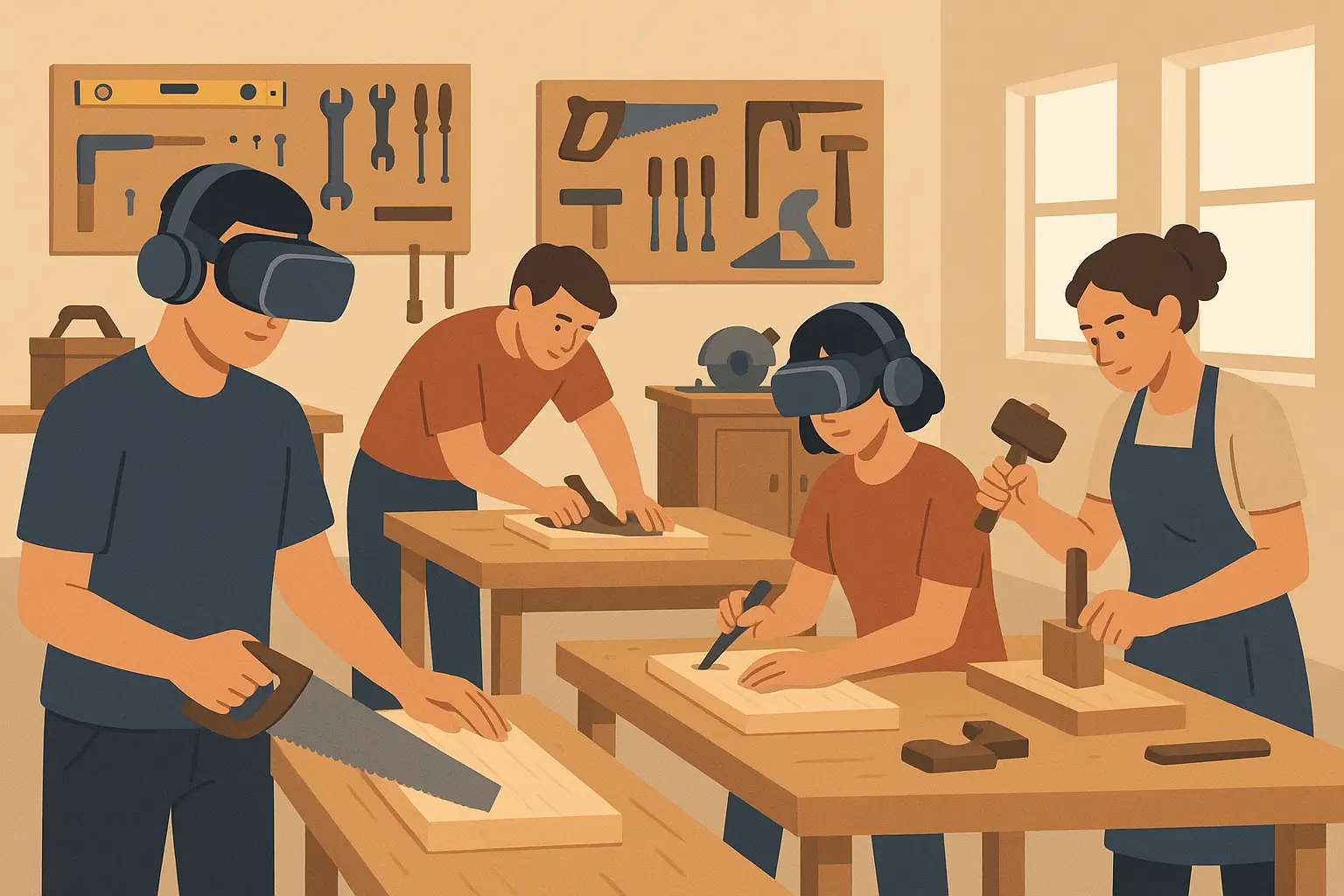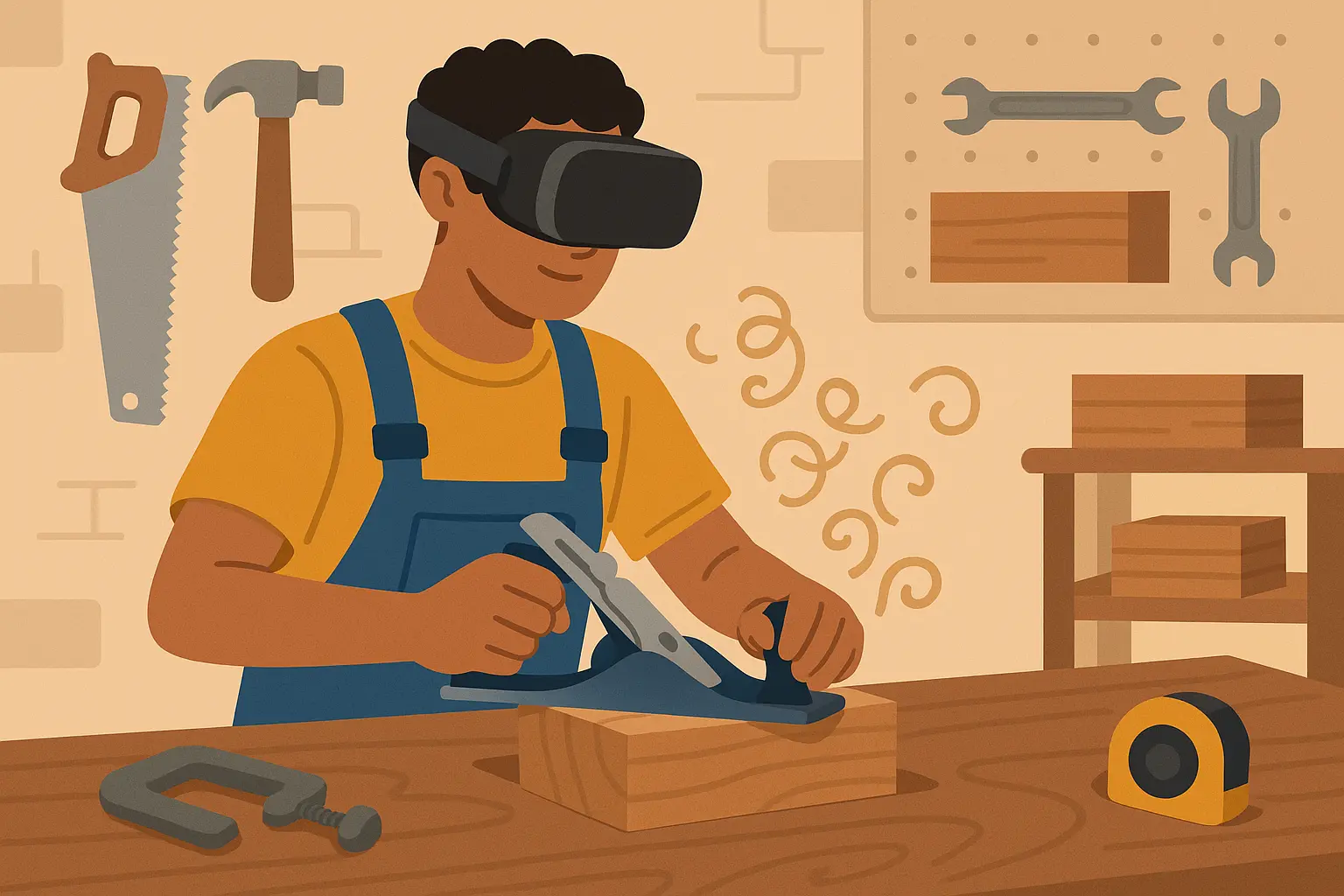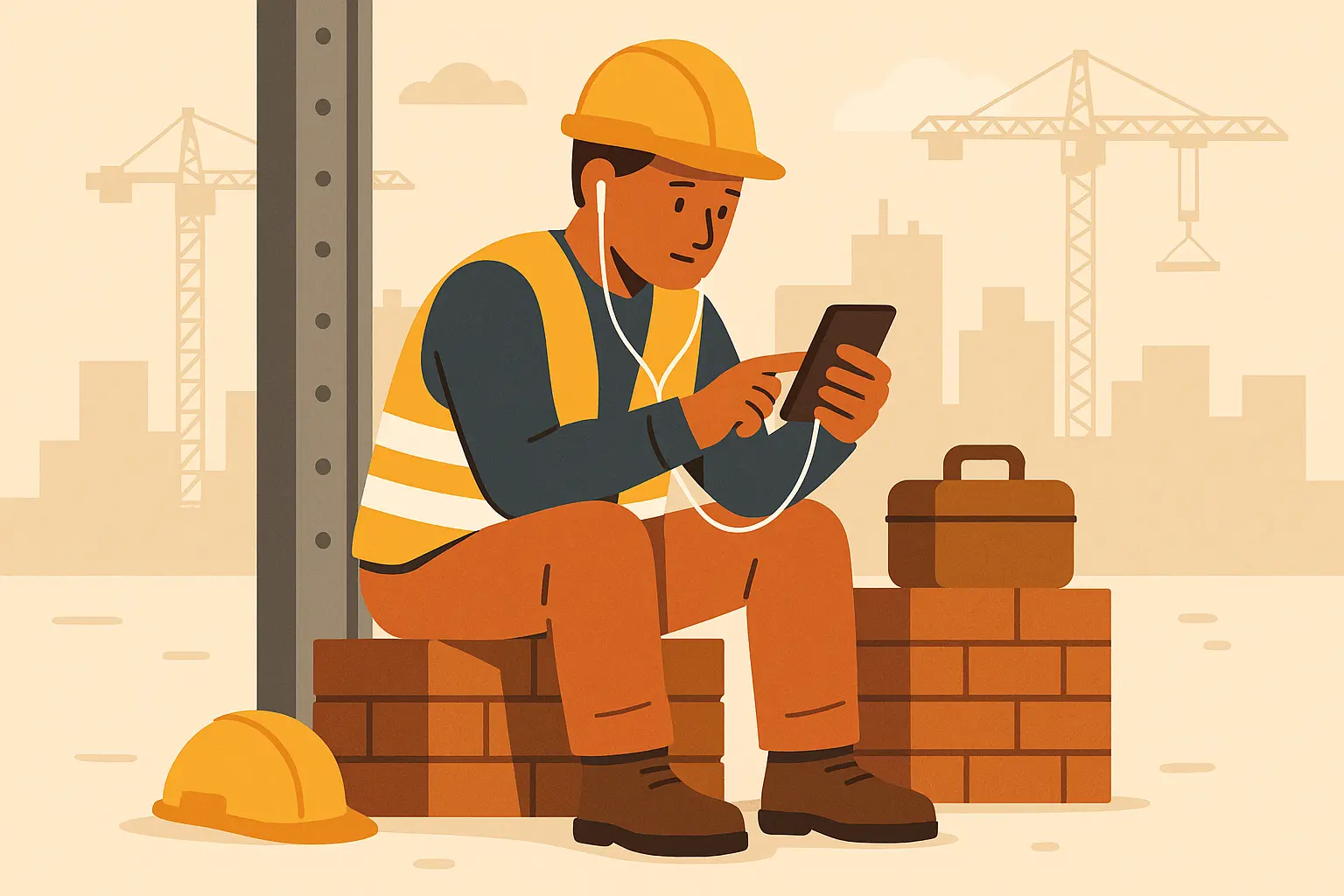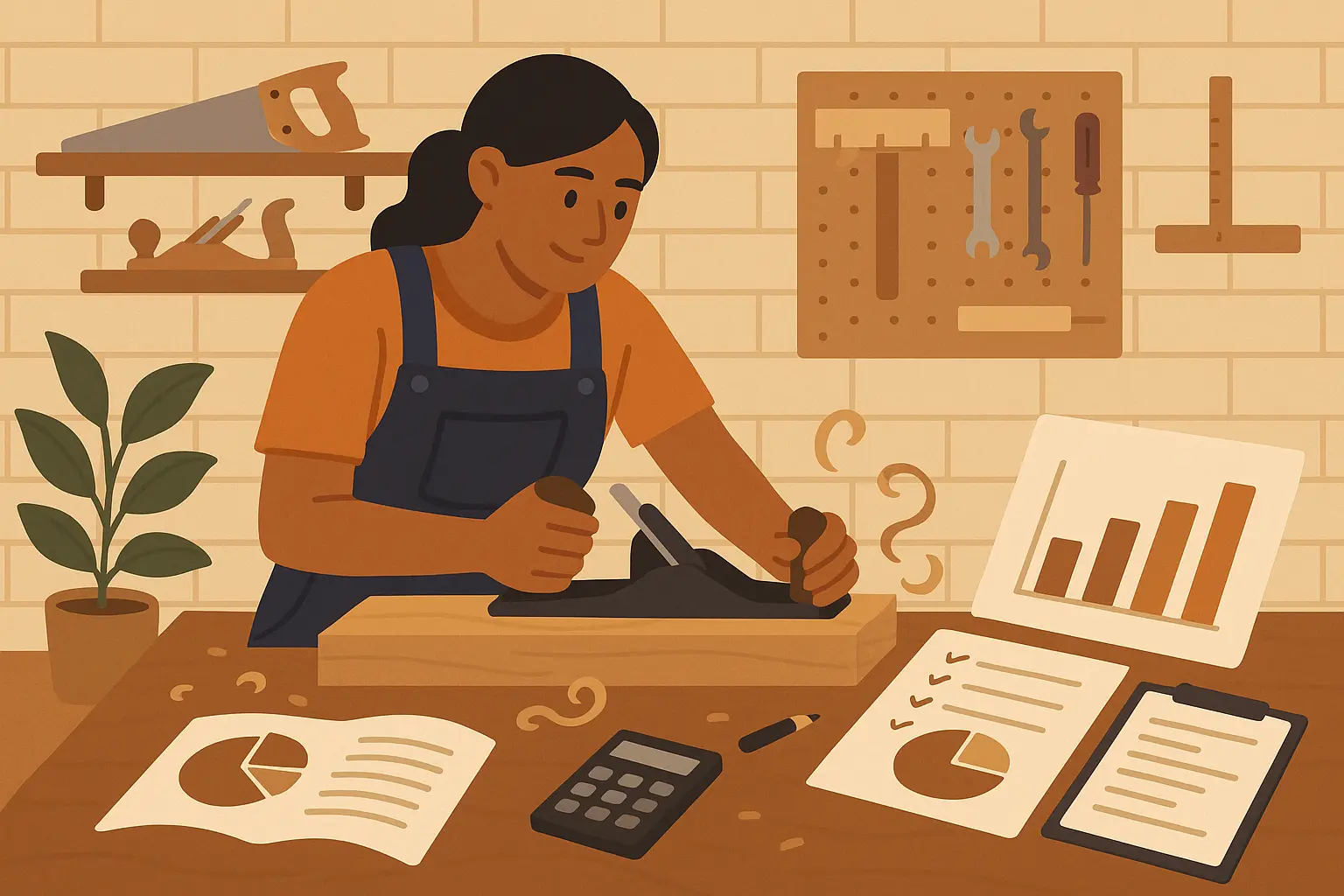After talking to dozens of carpenters and checking out different training options, I realized there are some really practical alternatives that most people don’t hear about. This isn’t about shortcuts or get-rich-quick schemes – it’s about understanding how the carpentry world actually works today and taking advantage of training methods that can get you job-ready faster than traditional programs.
The job market for carpenters is looking pretty good right now – the Bureau of Labor Statistics says employment is projected to grow 4 percent from 2024 to 2034, with about 74,100 openings for carpenters projected each year. There’s never been a better time to explore these different pathways.
Table of Contents
-
Why Traditional Degree Timelines Don’t Tell the Whole Story
-
The Portfolio-First Revolution That’s Changing Everything
-
How Virtual Reality and Hybrid Learning Cut Years Off Your Timeline
-
Skills-First Market Reality: When Experience Trumps Degrees
-
What Happens When You Lose Your Carpentry Credentials
-
Final Thoughts
TL;DR
-
Traditional carpentry degrees take 1-2 years, but alternative pathways can get you job-ready in 3-18 months
-
Digital badges and micro-credentials often carry more weight with employers than associate degrees
-
VR training reduces safety certification time from 200+ hours to just 40-60 hours
-
Modern apprenticeships create degree-equivalent portfolios while you earn money
-
Geographic mobility can reduce training timelines by 6-12 months in high-demand markets
-
Lost credentials can derail career advancement – having backup documentation is crucial
Why Traditional Degree Timelines Don’t Tell the Whole Story
Here’s the thing – asking “how long does it take to become a carpenter” is like asking how long it takes to get good at cooking. It totally depends on what you want to do and how you go about it. I used to think you had two choices: community college or apprenticeship. Period. Man, was I limiting myself. The construction world has gotten way more creative about training people.
How long does it take to become a carpenter really depends on which path makes sense for your life right now. The industry has evolved way beyond the old-school options most people think about.
Breaking Down Those Rigid Academic Schedules
I used to think carpentry education was straightforward – pick a program, complete the requirements, get your certificate. But traditional degree structures are surprisingly inflexible and often packed with requirements that don’t directly translate to job skills you’ll actually use.
For those considering alternative education paths, understanding how long does it take to get a certificate can help you compare traditional degree programs with faster certification options that might better serve your career goals.
Associate Degree Programs: The 2-Year Myth
Here’s something that really frustrated me when I was researching this – those “2-year” associate degree programs? They’re rarely actually two years. Most require 60-72 credit hours including general education courses that have absolutely nothing to do with carpentry. You’ll be taking English composition and college algebra when what you really need is to learn how to read blueprints and use a circular saw safely.
Full-time students typically need 24-30 months to finish, while part-time enrollment stretches this to 4-5 years. I’ve watched too many people get burned out with this timeline when faster options exist that actually prepare you better for the job.
The question of how to become a carpenter through traditional education means navigating these extended timelines that honestly don’t always make sense for career-focused students.
|
Program Type |
Duration |
Credit Hours |
Cost Range |
Job Readiness |
|---|---|---|---|---|
|
Associate Degree |
24-30 months |
60-72 credits |
$8,000-$25,000 |
Moderate |
|
Certificate Program |
9-12 months |
30-45 credits |
$3,000-$12,000 |
High |
|
Online Fast-Track |
6 months |
N/A |
$750-$6,500 |
High |
|
Apprenticeship |
48 months |
N/A |
Paid training |
Very High |
Certificate Programs: Faster But Like Learning to Drive in a Parking Lot
One-year certificate programs are like learning to drive by only practicing in parking lots – you’ll nail the basics, but the first time someone asks you to navigate a complex custom home project, you might panic a little. They focus purely on carpentry skills and can be completed in 9-12 months of full-time study, but they skip some of the real-world business stuff you’ll need later.
My neighbor Sarah switched careers at 28 – she was burned out from office work and wanted to build things with her hands. She crushed the 10-month certificate program at our community college, but then reality hit. When she tried to start her own business, she realized she had no clue how to bid jobs or handle contracts. She ended up taking night classes for another six months just to learn the business side. Still worked out great for her, but it took longer than she expected.
If you want to become a carpenter quickly, certificate programs offer speed but you might need additional training later for career advancement.
The Continuing Education Reality Check
Even after completing your initial training, most states require 10-20 hours of continuing education annually to maintain professional certifications. This ongoing commitment isn’t usually mentioned in those glossy program brochures, but it’s something you’ll deal with throughout your entire career. Not a huge deal, but worth knowing upfront.
How Long It Really Takes to Master Essential Skills
Academic timelines don’t always match up with how long it actually takes to get good at this stuff. Getting decent at the basic carpentry skills – measuring accurately, cutting straight lines, knowing which end of the hammer to hold – happens on its own schedule, regardless of whether you’re in a semester system or not.
When people ask how long does it take to become a carpenter, they’re really asking about getting good enough to not mess up someone’s house. The development of real carpenter skills happens through hands-on practice that can’t be rushed, no matter what the program brochure promises.
Foundation Skills: The 200-400 Hour Reality
Getting competent at basic carpentry takes about 200-400 hours of actually doing it. That might sound like a lot, but it’s really just a few months if you’re practicing regularly. This can happen in a 6-month intensive program or be spread over two academic years – the total practice time stays the same. What changes is how efficiently you can pile up those hours.
I’ve seen students in accelerated programs put in 8-10 hours of practice daily, getting their foundation skills down in just 3-4 months. Others in traditional programs might only get 15-20 hours of hands-on time per week, stretching the same skill development over an entire academic year. Both approaches work – it’s just about what fits your life.
Advanced Techniques: The Next Level Challenge
Specialized skills need an additional 100-200 hours of focused practice each. Depending on your program structure and how quickly you pick things up, total competency development typically takes 18-36 months. Some people are naturals and pick it up faster, others need more time – and that’s perfectly normal.
The path to become a carpenter with advanced skills requires patience and consistent practice, regardless of which educational route you choose.
The Portfolio-First Revolution That’s Changing Everything
The most successful carpenters I know built their careers by focusing on what they could actually do rather than where they went to school. They combine micro-credentials, self-directed learning, and smart documentation of their skills to get hired faster and for better pay than people with traditional degrees.
The shift toward skills-based documentation is revolutionizing trades education, similar to how professionals in other fields are discovering whether a certificate is a degree and leveraging alternative credentials for career advancement.
The New World of Stackable Credentials
Modern carpentry education is moving toward stackable credentials that you can earn in weeks rather than years. This totally changes how we measure competency and career readiness, giving you way more control over your learning timeline.
Understanding how long does it take to become a carpenter through stackable credentials means looking at individual skill certifications rather than big, comprehensive degree programs.
Digital Badges That Actually Matter
Online platforms now offer carpentry-specific digital badges that verify skills in real-time. We can show what we know in specific areas through these badges – usually takes 2-4 weeks per badge if we’re focused. I’ve seen employers get more excited about these targeted credentials than general carpentry degrees because they show current, specific skills that they need right now.
My buddy Mike had been doing regular carpentry for 15 years and was getting tired of the same old projects. He spent his evenings for about two months getting certified in green building stuff – solar panel installation, energy-efficient framing, that kind of thing. Not gonna lie, he was pretty wiped out most nights juggling work and studying. But when a sustainable construction company started up in our area, those certificates made him stand out. He went from $22/hour to $28/hour, which isn’t lottery money, but it definitely helped with his kids’ college funds.
Industry Partnership Certificates: The Secret Weapon
Major tool manufacturers and building supply companies offer certification programs that typically take 3-6 months to complete but carry serious weight with employers. Often more so than traditional 2-year associate degrees, actually. These programs are designed by the companies that make the tools and materials you’ll use every day, so they’re incredibly practical and immediately useful on job sites.
Modern Apprenticeships: Creating Your Own Degree
The traditional apprenticeship model is evolving to include formal documentation processes that create degree-equivalent credentials through structured learning portfolios. This way, we’re making money while we learn instead of going into debt for school.
Becoming a carpenter through modern apprenticeships offers the best of both worlds – immediate income and comprehensive skill development.
Building Competency-Based Assessment Portfolios
Today’s apprenticeships want you to keep track of everything you do – and I mean everything. By the time you’re done, you’ll have logged about 8,000 hours of work across different types of projects. It’s like keeping a really detailed diary of your carpentry life for four years. This effectively creates a personalized degree program that takes 4 years but provides immediate earning potential from day one.
Now, apprenticeships sound great on paper – getting paid to learn? Sign me up! But let’s be real about the downsides. You’re probably going to start at minimum wage or close to it. You’ll be the person everyone sends to get coffee and clean up job sites. Some of the old-timers can be… let’s say “challenging” to work with. But if you can stick it out, it’s still one of the best ways to really learn the trade.
Apprenticeship Portfolio Checklist:
-
☐ Document 2,000 hours of framing experience
-
☐ Complete 1,500 hours of finish carpentry work
-
☐ Log 1,200 hours of cabinet installation
-
☐ Record 800 hours of trim and molding work
-
☐ Accumulate 1,000 hours of repair and renovation projects
-
☐ Obtain 500 hours of blueprint reading practice
-
☐ Complete safety certification requirements
-
☐ Document client interaction and project management skills
Cross-Trade Skills: Expanding Your Value
Today’s carpenters increasingly need to show they know the basics of electrical, plumbing, and HVAC work. This extends traditional apprenticeships by 6-12 months but can bump up your earning potential significantly. I’ve seen carpenters with these cross-trade skills make 20-30% more than their single-trade counterparts.
If you want to become a carpenter with maximum earning potential, investing time in cross-trade skills pays off big time in the long run.
Geographic Strategy: Location Matters More Than You Think
Apprenticeship requirements vary wildly by state and region. Some areas offer accelerated 18-month programs while others require 5-year commitments. Making geographic strategy part of your timeline optimization can save you years and thousands of dollars in training costs. Plus, some regions are just desperate for skilled workers and will fast-track your training.
How Virtual Reality and Hybrid Learning Cut Years Off Your Timeline
I’ll be honest – when I first heard about VR carpentry training, I rolled my eyes. How can you learn to swing a hammer through a headset? Turns out I was pretty wrong about that. The integration of virtual reality training, online coursework, and hands-on workshops is creating new pathways that compress traditional 2-4 year programs into 12-18 month intensive experiences.
VR Technology: Practice Without the Expensive Mistakes
VR training sounds all fancy and futuristic, but honestly? It’s pretty cool being able to “accidentally” cut through a support beam without the whole house falling down. Plus, no splinters while you’re learning. This technology allows students to practice complex techniques safely and repeatedly, which significantly reduces the time needed to develop muscle memory and spatial reasoning skills.
Safety Training That Actually Works
VR safety training can be completed in 40-60 hours compared to traditional 200+ hour programs, while giving you more comprehensive scenario-based learning. You can experience dangerous situations virtually and learn proper responses without any actual risk. It’s way more engaging than sitting through classroom lectures about ladder safety, and it sticks with you better because you’ve “lived” through the scenarios.
As of May 2022, the median annual wage for carpenters was $51,390, indicating substantial earning potential in this skilled trade, making efficient training methods even more valuable for quick career entry.
The question of how long does it take to become a carpenter becomes much more flexible when VR training eliminates traditional safety training bottlenecks.
Accelerated Theory: Learning at Your Own Pace
Online platforms now deliver building codes, mathematics, and materials science education in condensed formats that can be completed in 3-6 months rather than traditional semester-based systems. This flexibility means you can move faster through concepts you grasp quickly while spending more time on the stuff that makes your brain hurt.
AI-Powered Learning That Adapts to You
AI-powered educational platforms adjust to how fast you learn, allowing some students to master theoretical concepts in 8-12 weeks while others may need 4-6 months. The system personalizes your timeline based on your aptitude and what you already know, so you’re never held back by slower classmates or rushed through material you need more time to understand.
Mobile Learning: Maximizing Every Moment
Smartphone-based learning modules let you study during downtime on job sites, effectively adding 5-10 hours of learning per week without extending formal program duration. I know carpenters who completed entire certification modules during lunch breaks and commutes, turning dead time into productive learning opportunities.
Pro tip: If you’re working full-time and thinking about evening carpentry classes, stock up on coffee and warn your family you might be a zombie for the first month.
Skills-First Market Reality: When Experience Trumps Degrees
The construction industry’s labor shortage has created a market where what you can actually do often matters more than your formal credentials. This has led to alternative career pathways that bypass traditional degree requirements entirely, and honestly, some of these routes get you better jobs faster than conventional education.
The trend toward skills-based education is gaining momentum nationwide. “Alabama loosened math and science requirements for high schoolers” according to The Hechinger Report, allowing students to replace traditional academic courses with career and technical education classes, including carpentry and construction programs.
When you become a carpenter through skills-first programs, you’re entering a job market that values what you can do over where you went to school. The path to how to become a carpenter has never been more flexible or employer-friendly.
Direct-to-Employment Programs: Skip the Classroom
Many contractors now offer direct training programs that guarantee employment upon completion. These typically last 6-18 months and focus on immediate job readiness rather than comprehensive theoretical knowledge. You learn exactly what you need for the specific role, nothing more, nothing less.
For those considering non-traditional paths, understanding careers that don’t require a college diploma can open your eyes to the many opportunities available in skilled trades.
Before you shell out money for any program, spend a Saturday visiting actual job sites. Ask the carpenters what they wish they’d learned in school. You’ll get some brutally honest answers that might save you time and money.
Specialized Focus Programs: Higher Pay, Faster Timeline
Programs focusing on high-demand specializations can be completed in 3-6 months and often lead to higher starting wages than general carpentry degrees. The specialization makes you immediately valuable in a specific niche rather than competing with everyone else for general carpentry positions.
|
Specialization |
Training Duration |
Average Starting Salary |
Job Availability |
|---|---|---|---|
|
Trim Carpentry |
3-4 months |
$45,000-$55,000 |
High |
|
Cabinet Making |
4-6 months |
$48,000-$62,000 |
Moderate |
|
Framing |
2-3 months |
$42,000-$52,000 |
Very High |
|
Finish Carpentry |
4-5 months |
$46,000-$58,000 |
High |
|
Custom Millwork |
6-8 months |
$52,000-$68,000 |
Moderate |
Entrepreneurship Track: Be Your Own Boss
Business-focused carpentry programs that include contractor licensing preparation typically add 2-4 months to traditional timelines but can result in immediate self-employment opportunities. If you’ve got an entrepreneurial spirit, this route can have you running your own carpentry business within a year of starting your education.
Geographic Mobility: Your Secret Advantage
Carpenters who are willing to relocate for opportunities can often access accelerated training programs in high-demand markets. This can potentially reduce traditional timelines by 6-12 months while securing higher-paying positions in areas desperate for skilled workers.
Despite limited employment growth, the US Bureau of Labor Statistics projects about 79,500 job openings for carpenters each year over the decade, creating significant opportunities for those willing to be geographically flexible.
The decision to become a carpenter can be accelerated significantly by choosing your training location strategically. Becoming a carpenter in high-demand markets often means access to better resources and faster job placement.
Disaster Recovery Specialization: Fast Training, High Pay
Emergency response carpentry training programs typically take 4-8 weeks but provide access to high-paying temporary work opportunities. These positions can fund further education while building valuable experience. I know several carpenters who used disaster recovery work to bootstrap their entire careers.
After Hurricane Ian in Florida, my friend James completed a 6-week disaster recovery carpentry program and earned $85,000 in just 8 months of temporary work. He used this income to fund his transition into high-end custom home building, ultimately starting his own company two years later. The work was intense and he was away from home a lot, but it set him up financially.
Educational institutions are responding to this skills-first market reality. “The American College of Building Arts (ACBA) in Charleston” according to Plough, is pioneering integrated approaches that combine traditional craftsmanship with liberal arts education, creating more well-rounded carpenters who can think critically about their work.
What Happens When You Lose Your Carpentry Credentials
Look, I get it – nobody wants to think about losing their paperwork when they’re just starting out. But as the carpentry field evolves, we increasingly need to document, replace, or supplement our credentials for career advancement. Losing your credentials can seriously derail your progress, and it happens more often than you’d think.
The path to become a carpenter doesn’t end with completing your training – maintaining proper documentation throughout your career is equally important.
Building and Maintaining Your Professional Portfolio
Modern carpenters need to keep comprehensive documentation of their skills, certifications, and project experience. Digital portfolios have become essential for securing premium employment opportunities, and keeping everything organized and accessible is more important than ever.
Career advancement often requires proper documentation, and professionals who understand how to display certificates on wall can create impressive presentations of their qualifications that help secure better opportunities.
Here’s something nobody tells you: your back is going to hurt for the first few weeks of any hands-on program. Invest in good boots and maybe stock up on ibuprofen.
Digital Credential Management: Your Career Insurance
Professional carpenters increasingly need backup copies of their certifications and training documents. Lost credentials can delay job opportunities in an industry where verification of qualifications is becoming more stringent. I’ve seen carpenters miss out on great jobs simply because they couldn’t immediately prove their qualifications when an opportunity came up.
For carpenters who have completed their training but need replacement diplomas or certification documents, having reliable backup documentation ensures career opportunities aren’t delayed by missing paperwork.
For carpentry professionals who have completed their training but need replacement documentation of their achievements, ValidGrad offers a practical solution. Whether you’ve lost your carpentry certificate, need a backup copy of your trade school diploma for portfolio purposes, or want to display your credentials proudly in your workshop while keeping originals safe, ValidGrad’s diploma replacement services ensure your hard-earned qualifications are properly documented. Their fast turnaround times and professional quality make them ideal for tradespeople who can’t afford lengthy delays in their career advancement due to missing paperwork.
Not everyone who starts these programs finishes them, and that’s totally okay. Sometimes life gets in the way, or you realize that working outside in February isn’t your thing. Better to figure that out early than to force yourself through something that makes you miserable.
Final Thoughts
Look, here’s the bottom line: there are more ways to become a carpenter now than when my dad learned the trade 30 years ago. Whether you go the traditional community college route, jump into an apprenticeship, or try some of these newer online/VR programs, the important thing is just starting somewhere.
I’ve seen people burn out trying to do accelerated programs while working full-time. Be honest about what you can handle – there’s no shame in taking the slower route if that’s what works for your life.
The construction industry needs good people who show up on time, work hard, and aren’t afraid to learn new things. If that sounds like you, there’s definitely room for you in this field. Yeah, it’s physical work, and some days are going to be tough, but there’s something really satisfying about building things that last.
The construction industry’s evolving requirements mean that understanding essential documents for career advancement has become as important as mastering the craft itself.
The key is understanding what employers actually want and choosing your educational path accordingly. Skills matter more than degrees in this field, but having proper documentation of your achievements remains crucial for career advancement. Don’t let lost paperwork derail your progress when solutions exist to keep your credentials secure and accessible.
Whether you choose to become a carpenter through traditional education or alternative pathways, the opportunities in this field continue to expand. Becoming a carpenter has never offered more flexibility in terms of training options, timeline control, and career advancement possibilities.
Don’t overthink it too much – pick a path that fits your life right now, and get started. You can always adjust course later if you need to.









